Hypopressive crunches are a lesser-known way to strengthen the core and gain stability in the trunk of the body. Sometimes we cannot reduce our belly because the abdominal muscles are weak. As much as we do conventional abdominal exercises , it seems that they increase the belly even more.
Stay with us, because we will explain all the advantages of hypopressives and how to do them correctly to reduce your waist by a few centimeters. The best thing about these abdominal exercises is that they do not require any material, just good breath control. You can learn to make them at home whenever you want.
What are hypopressives?
First of all, let's talk about the characteristics of the abdominal wall. We all know the external part of the abdominal wall. They are the squares of the abdominals, which we try to strengthen so that they are marked on the skin. Abdominal exercises that we've all done, like crunches or leg raises, can strengthen the outer face of the abdominal core. However, let us know that the abdominal muscle also has an internal part that is not visible . The internal area of the core keeps the abdominals attached to the spine and gives us stability. If the muscles in this area are weak, the abdominals will sag forward and it will seem that we have more belly.
Sometimes people try to strengthen their abs or look thinner by trying exercises like shrugs. The frustration comes if these exercises do not manage to solve the problem of the belly, but even seem to make it worse. Hypopressive exercises strengthen the abdominals from within. Doing these exercises regularly turns the core into a natural belt that keeps the muscles in place.
Hypopressive sit-ups are abdominal contraction and breathing techniques to strengthen the internal abdominal wall. There are several exercises of this type, which can be done standing up, leaning on an object, sitting down or on the floor. If you have not tried them, perhaps they should be your first option to try to reduce the perimeter of the abdomen.
Learn about hypopressives online and their advantages
Find out why doing hypopressive abdominal exercises and the benefits .
- • Improve the tone of your abdominal girdle and pelvic floor.
- • Get a better posture.
- • Favor your breathing pattern
- • The hypopressive technique reduces intra-abdominal pressure.
- • Reduces pressure on the pelvic floor.
Benefits of Hypopressive Crunches: They can help treat the following
The exercises work well for some medical conditions:
- • Hernia inguinal.
- • Prolapse (when the muscles and tissues of the pelvis cannot support the organs because they become damaged or weakened).
- • Urinary incontinence.
Also, like all physical exercises, hypopressives will provide us with mental well-being and (what most interests most people) they will help us reduce our belly a little .
Hypopressive abdominal gymnastics
If you want to start doing hypopressive abs at home , here we will explain several exercises. You will only need an abdominal mat to put it on the floor. Others are done standing up. Trainers and physical therapists recommend them.
1. Supine hypopressive exercise on the floor
- We place ourselves on a mat keeping the back of the head, back and buttocks in contact with the ground.
- We raise and bend our legs forming an arc, but we keep our feet glued to the ground.
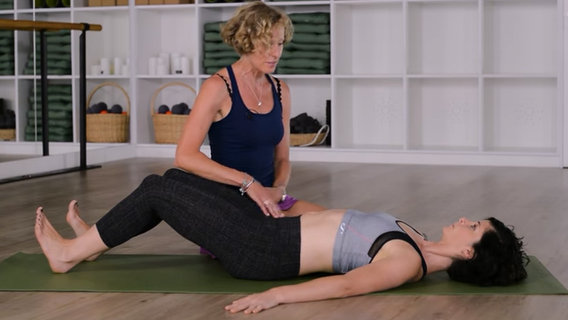
- We leave the arms in contact with the ground, but away from the body.
- Before you start, learn to breathe. Take several breaths filling your rib cage with air (do not breathe with your belly). When you breathe in, your ribs should open up. When you exhale, you should feel your abdomen drop down.
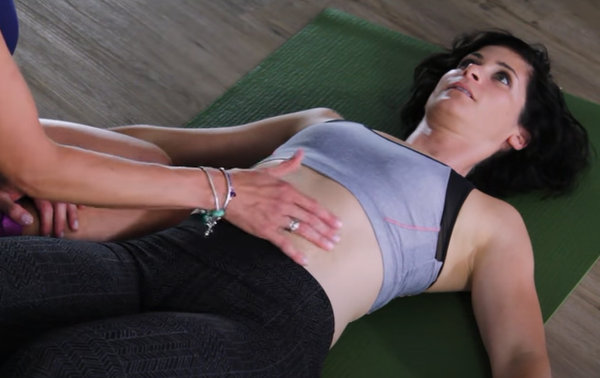 |
| Inhalation position. |
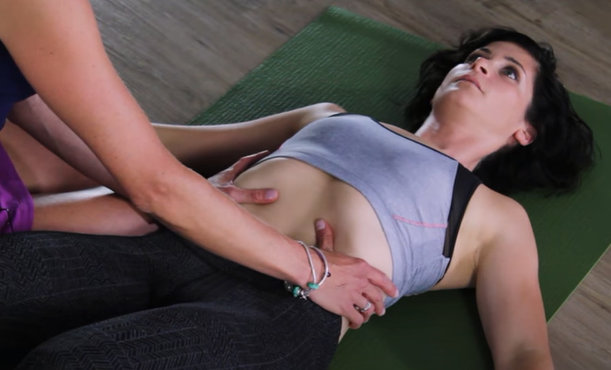 |
| exhalation position. |
- After removing the air from the rib cage, we see how our diaphragm rises and the abdomen descends. Our abdomen will be completely attached to the body. We must learn to maintain this position, for several seconds, with the body totally empty of air .
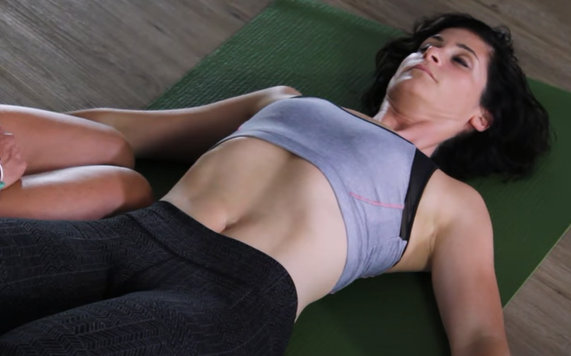 |
| After exhaling the air, the abdomen is kept close to the body for several seconds. |
- When we need to breathe, we will take another breath and fill the ribcage with air. Slowly, we will empty the air so that the abdomen descends again and we maintain the hypopressive position for several seconds.
 |
| Lateral view in the inhalation position. The rib cage fills with air. |
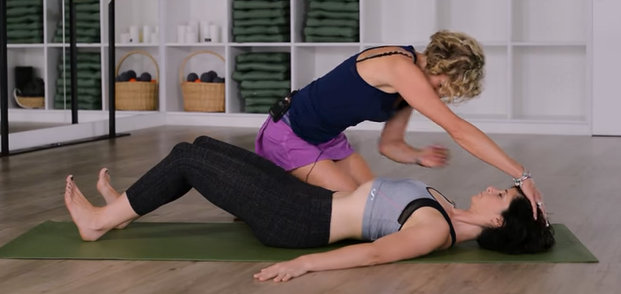 |
| Lateral view in the exhalation position. The ribcage is emptied of air. |
- We will repeat the hypopressive abdomen exercise as many times as necessary.
2. Standing hypopressive exercise
The previous exercise can also be done standing up. Let's see how it is.
- First, we stand up with the soles of our feet fully in contact with the ground.
- We will not be completely straight, but we will let the body lean a little forward (in the direction of the ground). The bottom of the foot will remain fully in contact with the ground.
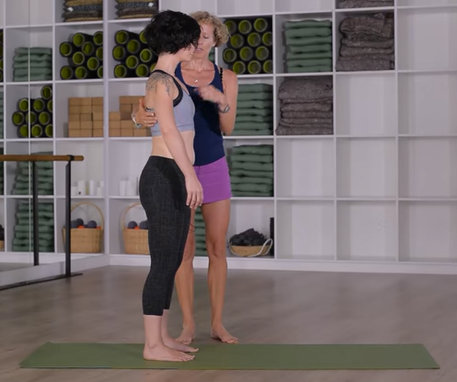
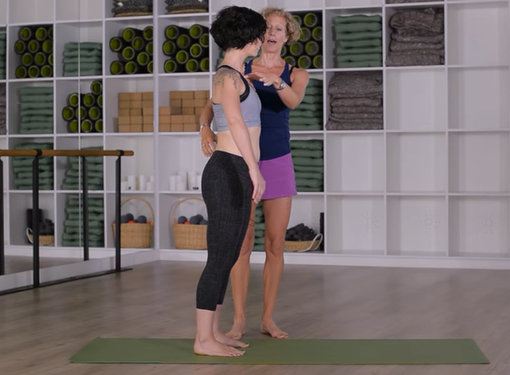
- We will place the arms with the tips of the fingers facing the ground.
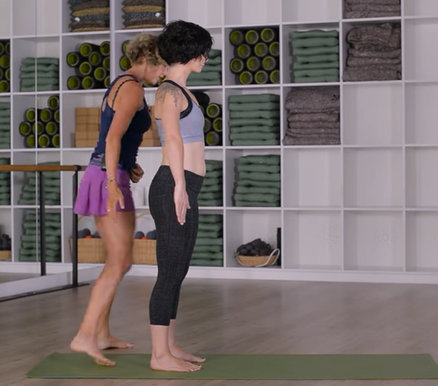
- Once we have the position, we will do several breaths. We will try to fill the ribcage with air (we will never breathe with our belly). We will exhale all the air so that the abdomen goes inwards and sticks to the body.
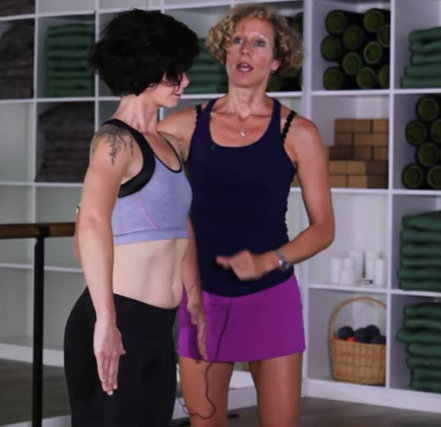 |
| Inhalation in side view. |
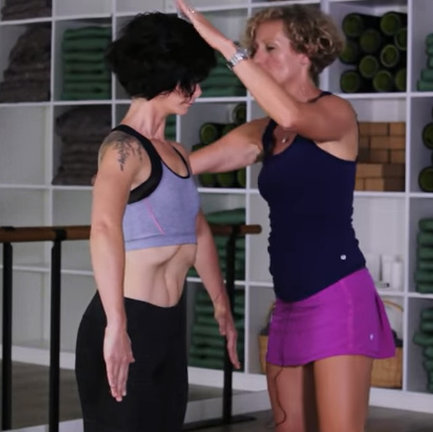 |
| Exhalation in side view. |
- When we learn to empty all the air and tuck in the abdomen, we will try to maintain that position for several seconds.
- We will catch air again when we need it to exhale again and repeat the hypopressive exercise .
- We can do this exercise several times.
3. Hypopressive exercises with the torso bent over and arms supported
Another hypopressive routine that is easy to do consists of leaning on an object (a wall, a piece of furniture, a table...) and leaning your torso. Let's see how to do this exercise to strengthen your inner abdomen.

- We will place ourselves with our arms resting on something and we will incline our torso, as seen in the image on the left.
- We will keep the abdominals contracted and we will take air to fill our ribcage.
- We will release all the air so that the diaphragm rises and, with empty lungs, we will try to put our abdomen in as much as possible.
- We will maintain the position with the abdomen close to the body for 30 seconds, as can be seen in the photo on the right.
- Every 5 seconds, we will imagine that we want to bring the abdomen in and up (as indicated by the red arrows in the photo) and we will try to do so. In this way, we will not relax the muscles when we exhale.
How many times do you have to do this exercise? We recommend doing it 5 times maintaining the exhalation position for 30 seconds (with the abdomen close to the body).
Hypopressive abs at home and anywhere
You've already seen how easy the hypopressive abs technique for beginners is . There are many different postures and variants. Breathing and contraction of the abdomen are always done in the same way:
- • Inhale until the rib cage is filled with air (never breathe with your belly).
- • Exhale the air and stick the abdomen to the body (bring the abdominals in).
- • Keep the abdominals contracted and drawn in for several seconds (without air in the lungs).
Let's see other positions to perform the exercise:
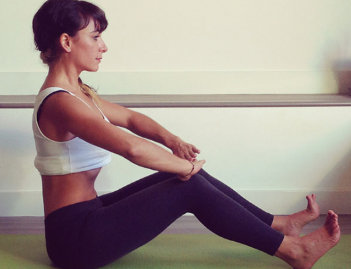 |
| Seated hypopressive abdominals . |
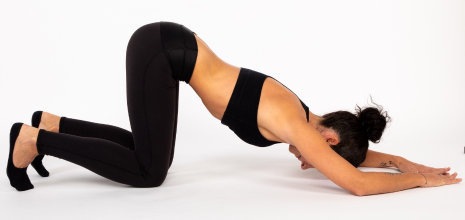 |
| Plank hypopressives. |
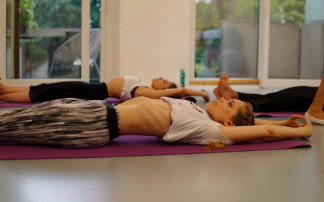 |
| On the floor with arms outstretched. |
Don't have time to do your hypopressive abdominal exercises?
If work and obligations do not allow you to do hypopressives , don't worry! Lucky for you, this activity is so easy that you can do it while you're driving in the car or sitting at your desk.
 |  |
| You can do your hypopressives while driving or working sitting down. |
Do you want another tip? In addition to doing your hypopressive abdominal exercises periodically, remember to always keep your abdomen close to the body throughout the day. Poor abdominal posture makes the waist circumference appear larger. Therefore, try to "educate" your brain to keep the abdomen in whatever you do: when you are walking, running, sitting, driving...
Frequently asked questions about hypopressive exercise
If you read this far, you already know how to carry out the exercise. !! Congratulations!! Now, you can stick around to go over some frequently asked questions with us.
Do I have to look for a hypopressive gym near me to do the activity?
As you have seen, they are a few very simple exercises, so you can do them at home when you have time. However, if you think you need a professional to help you with the technique, you should know that there are gyms and physiotherapy centers specialized in hypopressives . Look for a center in your nearest city.
Are hypopressive abs recommended for men and women?
Yes, both genders can benefit from strengthening their abdominal wall with these exercises.
Can you do hypopressive abdominal exercises during pregnancy?
There is a controversy about this. Hypopressive abs for women have become very popular. For this reason, many wonder if hypopressives for pregnant women are healthy. There are several compelling reasons for not recommending these exercises:
- Hypopressives could cause uterine contractions and harm the fetus.
- Pregnancy requires oxygenation. Hypopressives, precisely, consist of holding your breath, so they would not be advisable.
Do not do hypopressives in pregnancy or other exercises without first consulting your doctor.

Are postpartum hypopressive abs advisable?
In this case, yes, you can do them without fear, unless you have had a caesarean section. In this case, you will have to consult the doctor. After childbirth, you can help yourself with hypopressives for abdominal flaccidity .
Why are these exercises useful to reduce the belly?
You should know that hypopressive exercise does not burn fat. Fatty tissue in the body can only be burned with a specific diet. However, most of us have a bad abdominal posture . Our abdomen is usually off the hook and not attached to the spine due to bad habits. We can correct and improve our bad posture by doing hypopressives periodically. A strong abdominal girdle and well attached to the body can reduce the waist by several centimeters. Ideally, we should combine diet with hypopressive gymnastics if we want to lose belly.
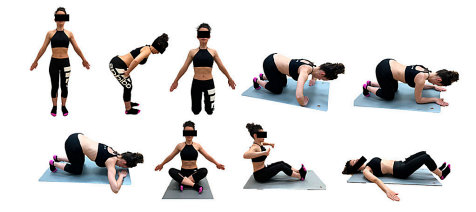
Should I stop doing conventional crunches?
It is not necessary that you abandon the typical abdominal exercises (such as shrugs, elevations...). Each type of exercise has its purpose. Conventional (hyperpressive) exercises tone the outer area of the abdomen. The hypopressives, for their part, build a good abdominal girdle because they strengthen the internal tissue. You can combine both.
Can I find a hypopressive gymnastics center in Barcelona?
Yes. In all large cities, there will be at least one center where they offer this type of exercise. To do hypopressive gymnastics in Barcelona , there are several places like CRIOS Gràcia - Fisioteràpia, Fisioteràpia i salut - Pilates and Physiotherapy Center, Fitness Bienestar, mooFit, Pilates and More, LUDUS BARCELONA, Bwell Clinic, The Class BCN or Kinefis physiotherapy and fitness .
Table of hypopressive abdominal exercises PDF
Since you already know the technique, here are several hypopressive exercise postures in PDF that you can do. Download and print it. You can stick the sheet in your room to do the exercises whenever you want.
We hope this online hypopressive guide has worked for you. There is no problem in dedicating a few minutes of the day to this activity. Remember to drink plenty of water after exercise. Reduce your waist and feel good about yourself !




![CÓMO MONTAR UN GIMNASIO EN CASA CON POCO PRESUPUESTO [GUÍA 2024]](/modules//smartblog/images/296-home-small.jpg)




